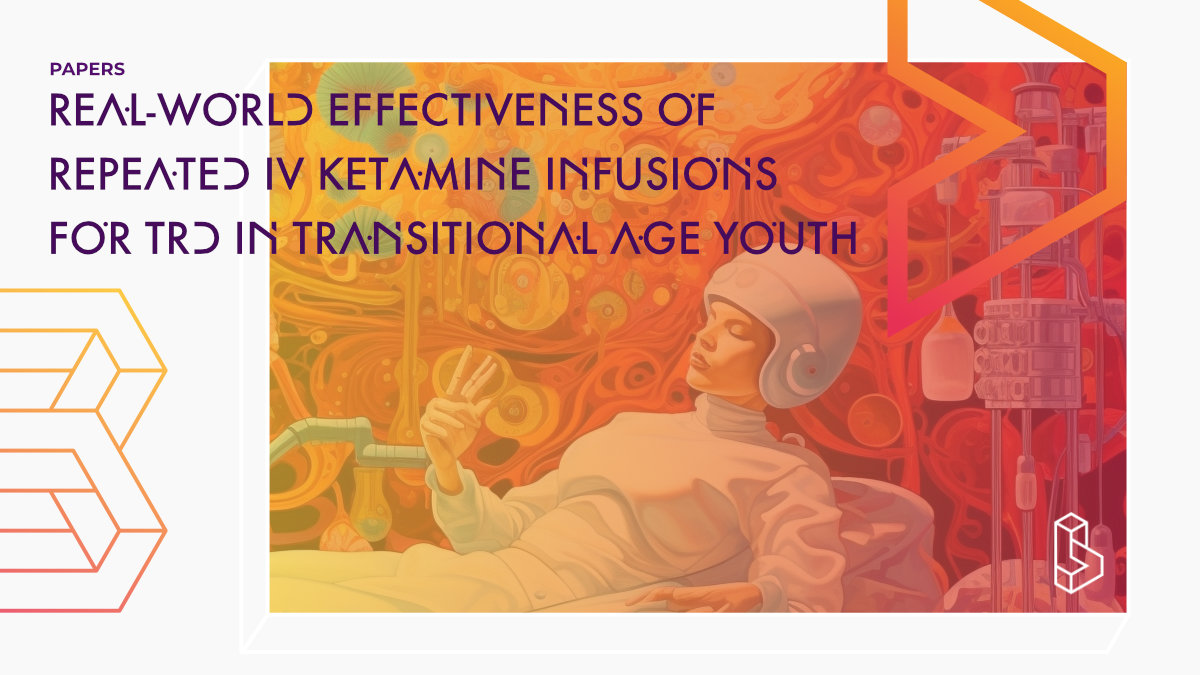This retrospective analysis (n=52) investigates the efficacy of ketamine (35-52mg/70kg; 4x) for treating treatment-resistant depression (TRD) in transitional age youth (TAY; age 18-25), comparing them with matched adults. The study finds significant reductions in depression, anxiety, and suicidal ideation in the TAY group, with effect sizes indicative of clinically meaningful improvements. The benefits and safety outcomes in the TAY group were comparable to the GA group, suggesting ketamine can be equally effective and well-tolerated in younger patients with TRD.
Abstract of Real-world effectiveness of repeated IV ketamine infusions for TRD in transitional age youth
“Background: Ketamine is an emerging treatment for treatment-resistant depression (TRD) associated with rapid and robust improvements in depressive symptoms and suicidality. However, the efficacy and safety of ketamine in transitional age youth (TAY; age 18-25) populations remains understudied.
Methods: In this retrospective analysis, TAY patients (n = 52) receiving ketamine for TRD were matched for sex, primary diagnosis, baseline depression severity, and treatment resistance with a general adult (GA) sample (age 30-60). Patients received four ketamine infusions over 2 weeks (0.5-0.75 mg/kg over 40 min). The primary outcome was the change in Quick Inventory of Depressive Symptomatology Self-Report 16-item (QIDS-SR16) over time. Secondary outcomes were changes in QIDS-SR16 suicidal ideation (SI) item, anxiety (Generalized Anxiety Disorder 7-item (GAD-7)), and adverse effects (ClinicalTrials.gov: NCT04209296).
Results: A significant main effect of infusions on reduction of total QIDS-SR16 (p < 0.001), QIDS-SR16 SI (p < 0.001), and GAD-7 (p < 0.001) scores was observed in the TAY group with moderate effect sizes, indicative of clinically significant improvements in depression, anxiety, and suicidality. There were no significant differences between TAY and GA groups on these measures over time, suggesting comparable improvements in both groups. Safety and tolerability outcomes were comparable between groups with only mild, transient adverse effects observed.
Conclusion: Ketamine was associated with comparable clinical benefits, safety, and tolerability in a TAY sample as compared to a matched GA TRD sample.”
Authors: Noah Chisamore, Kevork Danayan, Nelson B. Rodrigues, Joshua D. Di Vincenzo, Shakila Meshkat, Zoe Doyle, Rodrigo Mansur, Lee Phan, Farhan Fancy, Edmond Chau, Aniqa Tabassum, Kevin Kratiuk, Anil Arekapudi, Roger S. McIntyre & Joshua D. Rosenblat
Find this paper
https://doi.org/10.1177/02698811231171531
Open Access | Google Scholar | Backup | 🕊
Cite this paper (APA)
Chisamore, N., Danayan, K., Rodrigues, N. B., Di Vincenzo, J. D., Meshkat, S., Doyle, Z., ... & Rosenblat, J. D. (2023). Real-world effectiveness of repeated intravenous ketamine infusions for treatment-resistant depression in transitional age youth. Journal of Psychopharmacology
Study details
Compounds studied
Ketamine
Topics studied
Treatment-Resistant Depression
Depression
Study characteristics
Open-Label
Participants
52
Humans
Authors
Authors associated with this publication with profiles on Blossom
Joshua RosenblatJoshua Rosenblat is a psychiatrist and clinician-researcher at the Mood Disorders Psychopharmacology Unit at the University of Toronto. He is also the Medical Director of the Canadian Rapid Treatment Centre of Excellence (CRCTE), Chief Medical & Scientific Officer of Braxia Scientific and co-founder of 1907 Research.
Linked Research Papers
Notable research papers that build on or are influenced by this paper
Real World Effectiveness of Repeated Ketamine Infusions for Treatment Resistant Bipolar DepressionThis real-world study (n=66) assessed the effects of four sub-anaesthetic doses of intravenous ketamine (35-52.5 mg/70kg) in participants with bipolar depression. Significant antidepressant effects were measured using the QIDS-SR, and further reductions were observed following each subsequent infusion. The rate of remission was 20% after all infusions.
Real world effectiveness of repeated ketamine infusions for treatment-resistant depression with comorbid borderline personality disorder
This retrospective analysis (n=100) of the effectiveness of ketamine (35mg/70kg) for borderline personality disorder (BPD) in those with treatment-resistant depression (TRD) finds that intravenous ketamine significantly reduces symptoms of depression, borderline personality, suicidality, and anxiety in patients with comorbid BPD and TRD. Both BPD-positive and BPD-negative groups showed significant improvements in the primary outcome measures, with no significant difference between groups.
Linked Clinical Trial
Chart Review of Patients Undergoing Ketamine InfusionsThis retrospective analysis aims to look at past data in order to further develop our understanding of ketamine in the use of psychiatry.

